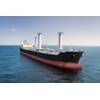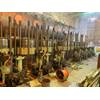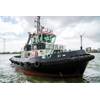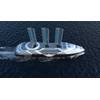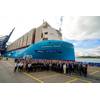Wärtsilä Modular Waterjets Upgraded
The technology group Wärtsilä has announced that its LJX series of modular waterjets has been upgraded to deliver even greater efficiency with low levels of cavitation and underwater noise. Following this upgrading, the company’s modular waterjets will be redesignated as the Wärtsilä WXJ series.
The development is based on a new axial pump design, which boosts performance with an increased thrust of as much as 3 percent, while the improved cavitation margins help reduce the environmental impact by lowering noise levels. This is very much in line with Wärtsilä’s Smart Marine vision to lead the maritime industry into a new era of ultra-high efficiency, improved safety, and a reduced environmental impact.
The new WXJ pump, which is an integral part of the waterjet technology, has been tested extensively, both in computational fluid dynamic (CFD) simulation and with model testing. With this successful upgrade, Wärtsilä is now in a position to supply global markets, including China and other Asian countries, with highly efficient waterjet solutions.
The Wärtsilä WXJ modular waterjets are aimed at various global market sectors, including high-speed ferries, frigates and other fast speed naval vessels, yachts, shallow draft vessels, large fast crew vessels, and large fast supply vessels.
Wärtsilä axial waterjets are single stage, compact, high performance systems that combine mixed flow properties with an axial construction. This results in much less space being needed on the vessel’s transom, and greatly increased waterjet cavitation margins for optimum vessel operational flexibility. For naval architects, the axial jet technology creates the possibility to apply a larger power density onto narrower hulls in order to achieve top vessel performance.
Unlike a non-axial design, the Wärtsilä waterjet does not expand in a radial direction downstream. As the water flow is directed through the pump along the most efficient path, it is easier to fit the jet to the available transom space. The reduced transom size also decreases the weight of the installation significantly. These weight optimizations and savings can be as high as 20% compared to non-axial jet designs.
Thanks to the increased pump cavitation margin of 35% and the lower impeller tip speed, more power can be introduced to the pump during maneuvering. This results in a 15% higher maneuvering thrust and faster response to acceleration. Operating flexibility is improved thanks to the combination of the reduced number of shaft lines and the higher loads of the remaining engines.



